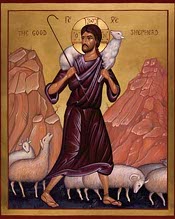Mount Calvary Church
Eutaw Street and Madison Avenue
Baltimore, Maryland
A Roman Catholic Parish
The Personal Ordinariate of the Chair of St. Peter
Anglican Use
Rev. Albert Scharbach, Pastor
Dr. Allen Buskirk, Choirmaster
Easter IV
8:00 A.M. Said Mass
10:00 A.M. Sung Mass
Breakfast following 10 A.M. Mass
____________________
Common
Healey Willan (1880-1968)
Missa de S. Maria Magdalena
____________________
Anthems
Herbert Howells (1892-1983)
The Lord is my shepherd; therefore can I lack nothing. He shall feed me in a green pasture and lead me forth beside the waters of comfort. He shall convert my soul and bring me forth in the paths of righteousness, for his name’s sake. Yea, though I walk in the valley of the shadow of death, I will fear no evil, thy rod and thy staff comfort me. Thou shalt prepare a table before me against them that trouble me; thou hast anointed my head with oil, and my cup shall be full. But thy lovingkindness and mercy shall follow me all the days of my life, and I will dwell in the house of the Lord for ever.
Here are the Dale Warland Singers.
______________
William Byrd (1540-1623)
Alleluia. Cognoverunt discipuli Dominum Jesum in fractione panis. Alleluia. Caro mea vere est cibus, et sanguis meus vere est potus: qui manducat carnem, et bibit meum sanguinem, in me manet, et ego in eo. Alleluia.
Alleluia. The disciples knew the Lord Jesus in the breaking of bread. Alleluia. My flesh is meat indeed: and my blood is drink indeed. He that eateth my flesh and drinketh my blood abideth in me: and I in him. Alleluia.
Here is the Ensemble Plus Ultra.
____________________
Hymns
#345 The King of love my shepherd is (ST COLUMBA) was written by Sir Henry Williams Baker (1821–1877). It is notable for its skillful meter, and its well-managed rhyme scheme of single and double rhymes, which control and shape the emotion very beautifully. Baker gave an Anglican slant to Psalm 23, interpreting it as a psalm of love and care, but stressing these qualities as evidenced in the Eucharist. The spread table of verse 5 becomes the altar on which the elements are displayed, and the delight comes as the believer takes the ‘pure chalice’; the unction, or anointing (from 1 John 2: 27), while bestowing grace in a spiritual sense, also has suggestions of a rite. This verse spreads its meaning through the whole hymn, allowing the words of Psalm 23 to acquire an extra significance: so that the last verse suggests that the length of days of a person’s life can be spent, figuratively, ‘within thy house for ever’, in the service and under the influence of the church, and then later in heaven. The singer can reflect back, and conclude that the first verses suggest the ransomed soul, sought out in love and rescued from sin (Baker’s version of ‘he restoreth my soul’). The beautiful use of the shepherd metaphor in verse 3, as the shepherd carries the lamb gently on his shoulder, is an illustration of the tenderness of Baker’s work: these lines were the last words spoken by Baker on his deathbed.
Be joyful Mary, heavenly Queen (REGINA COELI IUBILA) is a translation of Regina coeli, iubila, an anonymous 17th century hymn. The tune was written by Johann Leisentritt (1527-1586), and published in his Catholicum Hymnologium Germanicum in 1584.
I know that my redeemer lives (DUKE ST) is by the English Baptist Samuel Medley (1738-1799). The hymn uses a simple repetition of “He lives” to celebrate the resurrected Jesus who rules our lives and gives us eternal life. Christ is risen! Truly He is risen!
